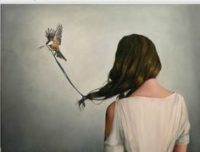You have no items in your cart. Want to get some nice things?
Go shoppingPsst, you. Hey kid. Yes you.
Why do you love art? Why do you listen to music or watch films or read?
As a girl I escaped for hours into the worlds of my books. I read to escape an unstable home life. I read to be the heroine of each new adventure. I read to learn, to feel, to see other possibilities.
I read for hundreds of reasons, but what I was really searching for were those moments of truth that could validate my life, for that one scene or line or word that described something I thought only I had felt or done. If it was in the book then someone else in the world had experienced it. It meant that I wasn’t alone. It could be something as small as one word or as large as a life philosophy. Donna Tartt’s The Goldfinch has plenty of both.
Winner of the Pulitzer Prize, The Goldfinch is a sprawling American epic that explores grief, death and art. Her long-awaited third book, it has all the touches of classic Tartt: a heavy literary slant, an observant eye, and a long-windedness that juxtoposes the action of the story.
The book is named after a 1654 Dutch painting by Carel Fabritius, an artist who was killed in his studio when a nearby gunpowder factory exploded, and the action of the novel begins with an explosion as well. Thirteen-year-old Theo Decker is at the New York Metropolitan Museum of Art with his mother when there is an explosion, leaving his mother dead and him with minor injuries. In the chaotic aftermath, Theo comforts a dying old man who gives him a signet ring and, in a possible war flashback, implores him to take The Goldfinch painting off the wall to protect it. The ring starts his relationship with a gentle old man named Hobie who gives him a rudder in his now-rudderless world. The stolen painting starts his torturous journey of grief, fear and an obsession of the possession that he associates with the day his mother died.
Like a Dutch painting, the story is exquisite from afar and incredible the closer we look at the details. In fact, many of the book’s strong points are in the quiet moments detailing Theo’s thoughts, theories and overall life philosophies. That said, the novel has been criticized for its long windedness and dull, unnecessary explanations. There are moments when Theo’s musings can seem at best a bit of an exaggeration coming from a 13-year-old boy, at worst a completely wordy, overwhelming aside. Donna Tartt has never been known for being concise, and she certainly isn’t in this more than 800-paged behemoth.
Still, Theo has a lot to muse on. After his mother’s death, the novel follows two storylines: Theo’s dislocated adolescence dealing with the consequences of his mother dying, and the life of the stolen painting.
Theo is first hosted by The Barbour’s, an uppity Manhattan family with problems of their own, before his absent, alcoholic father returns and moves Theo to Las Vegas to live with him and his girlfriend, Xandra. It’s there that Theo meets Boris, his best and only friend in Vegas, who introduces him to a world of misbehavior and drugs. Though Boris might seem like the fun, wild counter character to Theo’s innocent, decent personality, Tartt is careful to show that Theo’s new delinquency is not a direct cause of his mother’s death nor his new friendship with Boris, but a unmooring of flaws that Theo already had.
The one thing tying it all together is the painting that Theo holds on to for years, unsure of how to return it and even more unsure if he wants to.
More than just an interesting, action-packed story line (surprising for a more-than-800-page novel), The Goldfinch finds its strength in the high-society philosophy of Dickensian characters. Though ripe with clichéd writing throughout the novel, Tartt avoids that in her conclusion and ends the novel poignantly with an over-arching look at history, art and humanity’s constant search for beauty.
Theo’s semi-foster parent and later business partner, Hobie, says:
If a painting really works down in your heart and changes the way you see, and think, and feel, you don’t think, ‘oh, I love this picture because it’s universal.’ ‘I love this painting because it speaks to all mankind.’ That’s not the reason anyone loves a piece of art. It’s a secret whisper from an alleyway. Psst, you. Hey kid. Yes you.
In The Goldfinch, Tartt teaches us that good art makes us feel, but great art shows us that we’re not alone. That art is about our constant quest for the tiniest clue that shows us we’re not alone. It’s about the art around us that somehow reaches us, that saves us, that says to us:
“Psst, you. Hey kid. Yes you.”

About Gina Mussio
Gina Mussio is an American writer living in Milan, Italy. Her work has appeared or is forthcoming in Matador Network, Transitions Abroad, The Culture Trip, Verge Magazine and Columbus Weddings, among others. When not writing she's likely reading, running or "researching" new foods and recipes. Find more of her writing at her website.






https://destinationhackathon.com/april-2018-calendar/
goldfinch is love.. thanks for important post